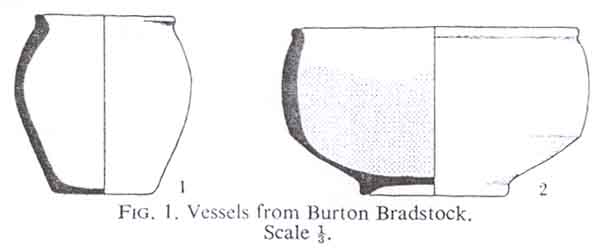Extract from Dorset Proceedings Vol. 87 Pages 114/115
ROMAN INHUMATION BURIALS
AT BURTON BRADSTOCK
AND CHICKERELL, DORSET
By R. A. H. FARRAR, M.A., F.S.A.
BURTON BRADSTOCK
The first part of this note is based on a description and sketch plan kindly
supplied by the Curator of the County Museum, Mr. R. N. R. Peers(1). In 1963
two inhumations were found in building flats (SY 486895) in the garden on
the south side of the Bridport Road opposite a private house (The Retreat)
west of the Anchor inn, Burton Bradstock. The site is about 50ft. above Ordnance
Datum, at the junction of the Bridport/Yeovil Sands and the Inferior Oolite
Limestones. The Curator was notified by the police, and the first burial was
promptly examined by him on 26/27 June, but much of the remains had been removed.
The first grave lay 51ft. south of the road and 6ft. east of the N.E. corner
of the new building on the east side of the site. The second (16/17 July)
lay some yards to the N.W., about 2lft. south of the road and 39ft. east of
the N.E. corner of the adjacent building to the N.W.
Skeleton no. I lay on its right side, at a depth of about 2ft. before the
ground was levelled, and was aligned at about 3l2°, i.e. with head almost
due N.W. The legs were tightly flexed, at a right angle to the spine, and
the right arm, at least, was extended alongside the body. The right half of
the mandible was recovered, with sound teeth

indicating an individual aged between 14 and 21 and probably about 16, according
to a dental surgeon. Fragments of charcoal,
six amorphous coarse ware sherds and one fragment of iron (nail?) were found
above the body, which was accompanied by a miniature jar placed, apparently
upright, by the head, and a bowl, position unknown, of Maiden Castle 'war
cemetery' type. Parts of both vessels are missing but the fresh breaks show
that they were intact before discovery (Fig. I).
1. Thanks are due to the builder, Mr. Rosamund of Shipton Gorge, for his
ready cooperation, and to Dr. Blades, County Pathologist, and Mr. White of
the County Library, for their assistance.
Skeleton no. 2 lay in a grave 6ft. long at a depth of between 2 and 3ft. and
had been partly excavated by Mr. White of the Dorset County Library before
overnight disturbance. Up to that time no pottery had been found, and the
burial was presumably unaccompanied. From reports and what remained of the
vertebrae Mr. Peers was able to determine that the body had been fully extended
with hands crossed over the abdomen, in an alignment of about 295°, i.e.
W.N.W. with head slightly tilted to the right. There was said to have been
some charcoal over the skeleton. Dr. A. N. Blades, County Pathologist, kindly
sectioned the skull and reported that it showed thickening and irregularity
with increased bony trabeculation, possibly due to Paget's disease.
Dating. Fully extended inhumation was the normal rite in the region in the
Roman period. A degree of flexing of the lower limbs, as in skeleton no. 1.
frequently occurs in the same period, although more characteristic of the
preceding Early Iron Age. Although both vessels accompanying burial 1 are
of types developed in the Iron Age 'C' phase, they remained popular after
the Roman conquest for an indefinite period and the writer is unaware of an
instance of the miniature version of the Durotrigian bead-rim jar in a pre-Roman
context. Both burials probably belong, therefore, to the Roman period, and
burial no. I more probably to the 1st century AD. than later. A coin of Constans,
found by Mrs. V. E. C. Young in her garden at 10 Barr Lane, Burton Bradstock,
was identified by Dr. J. P. C. Kent as type LRBC, 1, 133 of c. A.D. 34l(1)
THE POTTERY (Fig. 1)
No. 1. Hand-made bead-rim jar of Brailsford's Durotrigian type 4, but in
miniature; fairly hard sandy black or dark grey body, discoloured brown on
surfaces. The vessel appears rather worn, and little remains of the characteristic
burnished surface except on the inside of the rim.
No. 2. Hand-made bead-rim bowl of Maiden Castle 'war cemetery' type (Brailsford's
type 1), with under-base decoration; fairly hard sandy dark grey body, with
a thin brick-red zone or 'rind' below a dark grey to black surface in part
discoloured light grey externally. The vessel was horizontally burnished outside
and on the upper part of the interior; the matt underside of the base, within
the foot-ring, carries two burnished crosses (with bars respectively 5mm.
and 8mm. wide) superimposed to form an asterisk (2). The matt interior, stippled
conventionally in the drawing, shows faint erratic striations probably produced
by the potter wiping out the bowl before drying.
An interesting problem of technique is raised by the marked colour contrast
between the dense black of the burnished surfaces and the dark grey of the
matt, particularly noticeable where the irregular tool marks impinge upon
the latter. The exact coincidence with the tooling rules out 'fuming'-the
deposition of carbon particles in a damp and smoky kiln-as a special cause;
likewise the application of an iron-rich slip, or the employment by the potter
of a wet-hand or 'slurry' finish to bring up the clay fraction to cover a
gritty clay body. The writer owes to Mr. H. M. W. Hodges the suggestions that
it may be due (i) to burnishing with a piece of kidney haematite, which could
leave a deposit turning to magnetite on firing in a reducing atmosphere; (ii),
as seems more likely, to failure, in firing, to burn out carbon from the areas
rendered more resistant by burnishing; or (iii) a combination of both. Exposure
to hotter gases could explain the light grey discolouration. Mr. Hodges has
kindly undertaken to test these hypotheses.
1. Carson, Hill and Kent, Late Roman Bronze Coinage (1960)
2. Single crosses occur on examples from Maiden Castle and elsewhere.